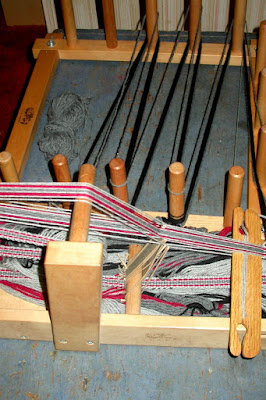I started out be getting some pictures from the company and I proceeded to do research on the web. There are lots of sources and people able to help. I got some additional information and passed it on to the carpenters...warp beams have to turn, the heddle rod has to be able to move...basic things like that. Some weeks later, I got 3 looms delivered to my house. I had them put in the garage and I spent several days sitting and looking at them to determine what would be best to do.
I thought about weaving a piece on my regular loom then attaching it to the warp weighted loom, but if I wove a band on the end that would be too time consuming. I decided to go with the traditional method of weaving...as close as I could get and still get the looms finished.
Rather than having a card woven band, I used my inkle loom and put a warp board next to it. This way I could get a band with 3 yard fringe that would become the warps on the loom.
 | |
| This is the third warp |
 | |
| Here is the warp/fringe from the second loom |
After weaving the width of the piece, I stitched it onto the warp beam from the loom.
 | |
| I stitched every 2 warp ends |
 | |
| The finished warp looked great hanging there |
I put the beam on the loom and started straightening the warps. You can see the groups or bundles of 20 threads here.
I now needed to hang the weights and chain the warp to keep it straight.
 |
| This shows the back half of the warp weighted. |
Chaining the warp is running a chain stitch across the with to space out the warps. According to some of the experts I talked to this is not a necessary step, but with my loom needing to be moved by stage hands, I wanted as much safety built in as I could get.
 | |
| This is process that I used, pretty basic |
 | |
| And here is the loom with both front and back weighted and chained. |
I worried for some time about the heddles, the basic source book (that I heard and read about but was not able to get a copy) talked about "knitted heddles". I finally found a web site that explained how to make them and showed an illustration. The problem was this method can slip. I will be having actors work on this loom and it will be moved around so I went with the more secure heddle method from back-strap weaving...a half-hitch.
I used a netting shuttle to stitch each of these half hitches around each warp end and then made a half-hitch between each to hold it secure.
 | |
| Stitching each half-hitch around the warp on the lease sticks |
 |
| Artsy shot of the same |
 | |
| Here's a close-up |
 | |
| And here you can see the half-hitch |
Once the heddles were tied on the first loom, I found that the angle of the uprights was too straight, they needed to be at more of an angle for the natural shed to hang right.
 |
| here the back layer of warps hang too close to the front |
 |
| here they hang farther back to make a better shed. |
I set up a shuttle to use to help get the weft across. Because the first warp had a narrow shed (my lack of knowledge on how much space was needed), I used a simple stick.
It is really amazing how much yarn you can put on this shuttle and still have it quite narrow to fit in the shed without rubbing the warps.
Because the beaters the carpenter made were not delivered to me (they needed to be "aged"), I used a warp sword that I already had to beat in the weft.
This sword has worked great to pack in the weft. I found that if I change to the next shed after putting the weft across, it is really easy to pack it in.
 |
| This is the first loom finished, some weaving done and ready for pick-up |
 |
| Loom Two was just two uprights that leaned against the wall |
When they came to pick up the looms, I had them bring drop cloths. They lifted the warp beam and then wound it down enclosing the heddles and then laying the weights on the drop cloth and wrapping the whole thing up. I think that is a good way to travel the looms.
 |
| Here is loom three |
While I was putting these together, I thought...I could make one up for me, it is an interesting historic artifact,... but then I decided I do not have enough time to weave on the looms that I have, so when would I do this...I never need to demonstrate this period of weaving.
As side note, I have lost my job of eleven years. There was a big reduction and I decided to take the package and move on. Working there has been less enjoyable for the last couple of years, but I will really miss the people that I worked with.
I am not sure what my next act will be...but it will all work out well.
I'm hoping to get my Bergman loom working in the time I spend at home and looking for a job!





























